
1. Buda
Budapest, for so long rather hidden from the eyes of the western tourist, a sort of poor man's Vienna on the River Danube, a city with a Royal Palace dating back to medieval times which was never lived in by Royalty, a city so often sacked and destroyed by war, occupied several times, and yet a city with much charm, with much interest. Originally two cities, eventually joined by a bridge, the fortified centre was that of Buda, with walls and ramparts crowning a limestone outcrop. Here are the Royal Palace, the Matthias Church and the Hilton Hotel. Around the foot of the rock by the river is the lower suburbs of Víziváros and Taban with some interesting churches which follow the tour of the Castle Area.
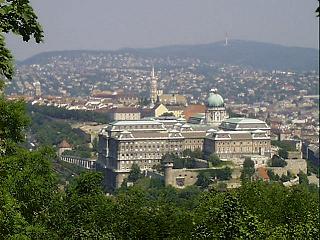
BUDA - The Castle Area
The castle area is now dominated by the Royal Palace, a huge building (or amalgam of buildings) with a dome. Destroyed many times, before the war it housed many of the government ministries but is now museum, art gallery and a library. The view of the Danube, Pest and Víziváros from the terrace is spectacular. And here too is possibly Hungary's most photographed church, although what do you call it? I am going to use its most common name to begin with!
Matthias Church (Mátyás-templom)
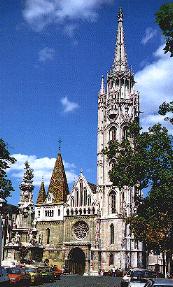
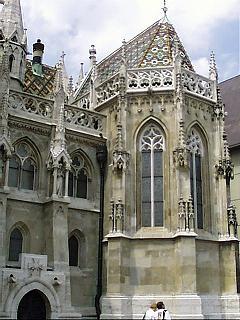
More correctly this is the church of Our Lady of Buda, but it is commonly called the Matthias Church a name given to the building by the C19 restorers in honour of a former king of that name. It is also called "The Cathedral" or "The Coronation church" but it has never served as a cathedral. The principle cathedral of Hungary is at Esztergom and until 1993 Budapest did not have a cathedral of its own. Of all the medieval churches of Buda Castle, this is the only one still in use. Destruction by the Turks, the suppression of monastic orders and World War Two bombs have put paid to the rest. The only other church is Protestant and just over 100 years old (see below).
The church today is principally C19, a sweet confection of a building that owes little to history. It was severely damaged in the siege by the Turks in 1541 who converted it into a mosque. After the retaking of the city in 1686 the ruined mosque became Jesuit, and was sandwiched between baroque monastic buildings, as well as being much rebuilt in that style itself. It was "restored" by Frigyes Schulek 1874-96 but in reality only the lower three stages of the tower, the south portal, the base of some of the outer walls and piers are medieval. The church was given a patterned tiled roof like those of the cathedrals of Zagreb and Vienna. It was badly damaged in World War Two and was closed for some 20 years as a further rebuilding took place. It is certainly picturesque outside and the 80 metre high steeple figures prominently in most views of the city.
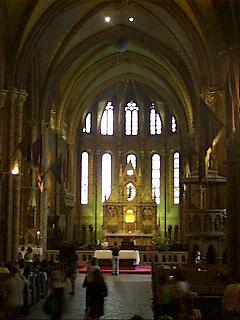
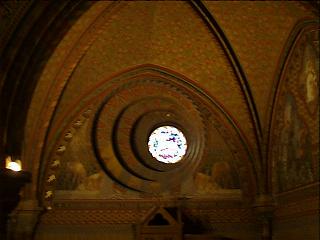
The interior is extremely dark, thronged with visitors to the point of being unpleasant, and walls have murals and patterns throughout. The pictures above have been lightened and the stained glass appear as if clear glass. (The guidebook's pic appears to be taken at night as all windows are dark!). Plenty of fake antiquities in the fittings and some memorials too. I really did not like it all if I am honest. The best bit for me was the unusual west window of the north aisle, a roundel set off-centre in a larger circle with stepped circles between the two. Of course this is probably a medieval feature found during restoration work, but it is interesting even if it is not old. I cannot remember seeing any other window like it.
The rest of the Upper Town....
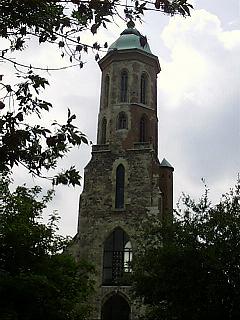
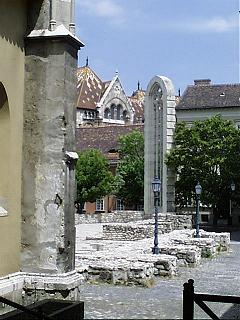
At the far end of the upper town is the tower of St Mary Magdalen (Magdolnatorony) c1475. Under Turkish occupation this church remained in use for Christians, the nave and aisles for Protestants and the chancel by Catholics, for several years; it was eventually turned into a mosque as well, called the Clock Mosque after the bells in the tower. After the expulsions of the Turks, the church was given back to the Franciscans who made some baroque improvements and repairs. The church was completely destroyed in World War 2, save the tower, and the foundations remain in a paved park, together with one restored window of the apse.
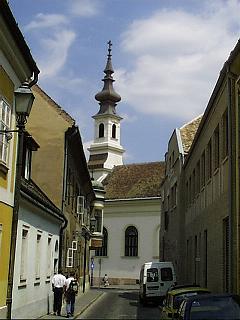
Close by, near the State Archive building and the Vienna Gate, is the Lutheran Church (Protestant) built in 1896 yet still in a baroque style in keeping with the surroundings. From here the road curves back towards the Matthias church and passes the Hilton Hotel. Incorporated into the street frontage is the base of a church tower which has been given an ultramodern lantern top. Be sure to enter the hotel, as it incorporates remains of the Dominican monastery of the C13 in the development of 1976. Not to everyone's taste perhaps.
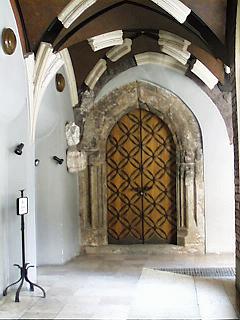
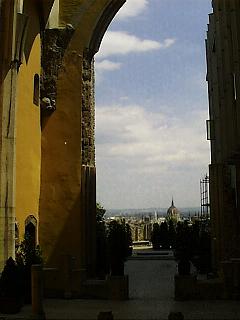
I believe the tower of the church now houses the hotel lifts. Nearby a passage leads to the former cloister walks. These have been reconstructed with metal vaulting which incorporate former vaulting ribs into the design. The door to the church survives from the east walk, and the hotel wine cellars seem to occupy some cellars at the opposite end. From the main lounge area a picture window looks out onto the church itself, formerly aisleless with a long apsidal chancel, dedicated to St Nicholas and now open to the sky and offering a stunning view across to the parliament buildings.
The Lower Town - Víziváros & Tabán
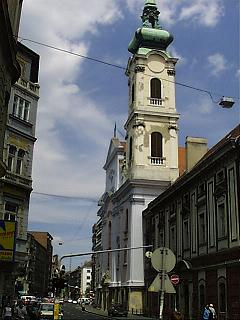
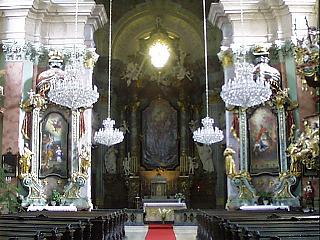
We left the Upper Town by the Vienna Gate and walked down a number of streets and steps towards the river. Here in the shadow of the castle are two more stunning C18 baroque churches. The first, in Fő útca, is the convent Church of the Order of St Elisabeth, dedicated I think to the Stigmata of St Francis. The monastery begun in 1703 was built on the site of a mosque, the church followed 1731-7, although the tower was not completed until 1751. This was originally Franciscan but they left the buildings in 1785 when the new order of nuns moved in. Badly damaged in World War Two, it seems to have been well-restored, but the visit was restricted to the west vestibule.
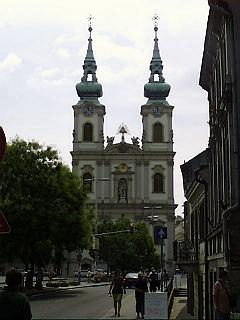
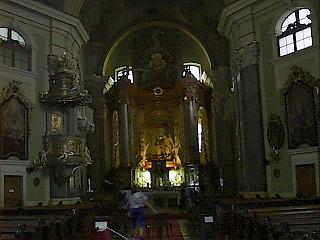
A little way to the south in Batthyány tér stands "one of Hungary's most beautiful baroque churches" dedicated to St Anne. Built 1740-62, it has twin towers at the west (ritual, actual north) end towards the square, and an oval nave with narrower east apse. again the visit was restricted to the west end vestibule, maybe because the lady seen was busy cleaning!
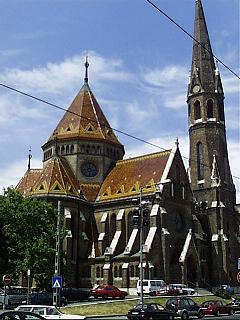
Prominent on the banks of the Danube is the Reformed Church in Szilágyi Dezső tér. Built 1892-6 to the designs of Samu Pecz, it has a short nave, crossing with lantern tower and five apsidal arms radiating from the crossing. In addition there is a near detached SW steeple (ritual, actual NE). Sadly all of the doors (and there were plenty!) were locked.
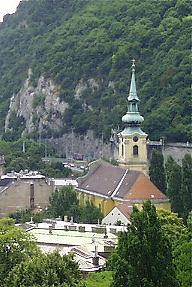
To the west of Buda Castle, between here and Gellért Hill is the suburb of Tabán and the church of St Katherine. This was the site of a medieval church, which became a mosque. Rebuilt 1728-36, the tower and choir followed 1750-3 and 1765 respectively. Fire destryed the interior in 1810 and the 1813 restored church was damaged again in the Hungarian Uprising of 1848-9. The church was restored again by 1880 when the present facade and tower-helm were constructed. The supposedly fine interior was inaccessible when I called, but I had a lovely chat to a lady outside about her Rastafarian-dreadlocked dog , apparently a Hungarian Sheepdog breed!
Somewhere close by here - probably in the complex of main roads, stood the Serbian Orthodox Cathedral of Buda. Built 1742-51, destroyed by fire 1810, rebuilt in 1814 and finally closed by the state and demolished in 1949.
Back to the Hungary Pages Intro and Index